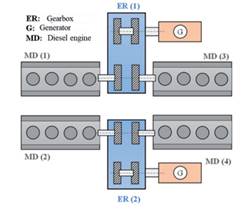Decision-making model for propulsion system selection
DOI:
https://doi.org/10.25043/19098642.249Keywords:
Maritime pollution, Greenhouse gases, Cost Effectiveness, Energy Saving, Propulsion SystemAbstract
History it has become evident that the military industry and its thriving action has generated change and development in different areas, and it is to be expected that a project as ambitious as the Strategic Surface Platform - PES focuses on the impact that internal combustion systems can generate in the design, therefore an evaluation model is developed for the selection of the propulsion system of the platform, which was based on the life cycle cost and performance of the main mechanical equipment, providing an additional tool for decision making. The cost side was estimated by breaking down the ROM (Rough Order of Magnitude) acquisition costs, maintenance costs and fuel and lubricant consumption costs, which leaves the performance side evaluated under the technical characteristics, considering the criteria of performance, reliability, delivered power and installation footprint; without leaving aside the mandatory requirements such as IMO TIER III gas emissions, reduction of the acoustic signature and the use of redundancy.
Downloads
References
AAKKO-SAKSA, P. T., LEHTORANTA, K., KUITTINEN, N., JÄRVINEN, A., JALKANEN, J. P., JOHNSON, K., JUNG, H., NTZIACHRISTOS, L., GAGNÉ, S., TAKAHASHI, C., KARJALAINEN, P., RÖNKKÖ, T., & TIMONEN, H. (2023). Reduction in greenhouse gas and other emissions from ship engines: Current trends and future options. In Progress in Energy and Combustion Science (Vol. 94). Elsevier Ltd. https://doi.org/10.1016/j.pecs.2022.101055.
AMMAR, N. R., & SEDDIEK, I. S. (2021). Evaluation of the environmental and economic impacts of electric propulsion systems onboard ships: case study passenger vessel. Environmental Science and Pollution Research, 28(28), 37851-37866. https://doi.org/10.1007/s11356-021-13271-4
BARLAS, B., & AZMI OZSOYSAL, O. (2001). The diesel-electric hybrid propulsion systems for Turskish frigates. https://www.researchgate.net/publication/266204021
CAPUTO, R. J. (2010). Impacts of Reducing Shipboard NOx and SOx Emissions on Vessel Performance. Massachusetts Institute of Technology.
GEERTSMA, R., NEGENBORN, R. R., VISSER, K., & HOPMAN, J. J. (2017). Design and control of hybrid power and propulsion systems for smart ships: A review of developments. In Applied Energy (Vol.194, pp. 30-54). Elsevier Ltd. https://doi.org/10.1016/j.apenergy.2017.02.060
GEERTSMA, R., VOLLBRANDT, J., NEGENBORN, R., VISSER, K., & HOPMAN, H. (2017). A quantitative comparison of hybrid diesel-electricand gas turbine-electric propulsion for future frigates. Defence Materiel Organisation, 451-458. https://doi.org/10.1109/ESTS.2017.8069321
HOLTROP, J., & MENNEN, G. G. (1977). An approximate power prediction method. 166-170. https://doi.org/10.3233/ISP-1982-2933501
LINDSTAD, H. E., & SANDAAS, I. (2016). Emission and fuel reduction for offshore support vessels through hybrid technology. Journal of Ship Production and Design, 32(4), 195-205. https://doi.org/10.5957/JSPD.32.4.150006
MORALES E., O., SILVA, A., ZÁRATE, F., & ARMADA DE COLOMBIA (2016a). Technical Concept Evaluation of configurations for the ESP propulsion system.
MORALES E., O., SILVA, A., ZÁRATE, F., & ARMADA DE COLOMBIA (2016b). Report Development of evaluation model for selection of the propulsion system of the Strategic Surface Platform - PES.
OHMAYER, H. F. (2012). Propulsion System Choices for modern Naval Vessels.
Royal Navy U.K. (n.d.). DUKE CLASS TYPE 23 FRIGATE. Retrieved January 22, 2023, from https://www.royalnavy.mod.uk/theequipment/ships/frigates/duke-class
SILATAN, S., EDALAT, P., & RAHIMI, M. (2014). Hybrid Propulsion System For New Generation Of Ships. www.SID.ir
ZHU, J., CHEN, L., WANG, B., & XIA, L. (2018). Optimal design of a hybrid electric propulsive system for an anchor handling tug supply vessel. Applied Energy, 226, 423-436. https://doi.org/10.1016/j.apenergy.2018.05.131.

Published
How to Cite
Issue
Section
License
Copyright (c) 2023 Cotecmar

This work is licensed under a Creative Commons Attribution 4.0 International License.
The authors who publish in this Journal certify that:
- The work submitted for publication in The Ship Science and Technology journal, was written by the author, given that its content is the product of his/her direct intellectual contribution.
- All data and references to material already published are duly identified with their respective credits and are included in the bibliographic notes and quotations highlighted as such.
- All materials submitted for publication are completely free of copyrights; consequently, the author accepts responsibility for any lawsuit or claim related with Intellectual Property Rights thereof, Exonerating of responsibility to The Science and Technology for the Development of Naval, Maritime, and Riverine Industry Corporation, COTECMAR.
- In the event that the article is chosen for publication by The Ship Science and Technology journal, the author state that he/she totally transfers reproduction rights of such to The Science and Technology for the Development of Naval, Maritime, and Riverine Industry Corporation, COTECMAR.
- The authors retain the copyright and transfer to COTECMAR the right of publication and reproduction of the work which will be simultaneously subject to the Creative Commons Attribution License (CC -BY) , which allows the license to copy, distribute, display and represent the work and to make derivative works as long as it recognizes and cites the work in the manner specified by the author or licensor.
- For more information about the Creative Commons Attribution License (CC -BY) and his use and scope, please visit the following web page https://creativecommons.org/licenses/by-sa/4.0/legalcode








